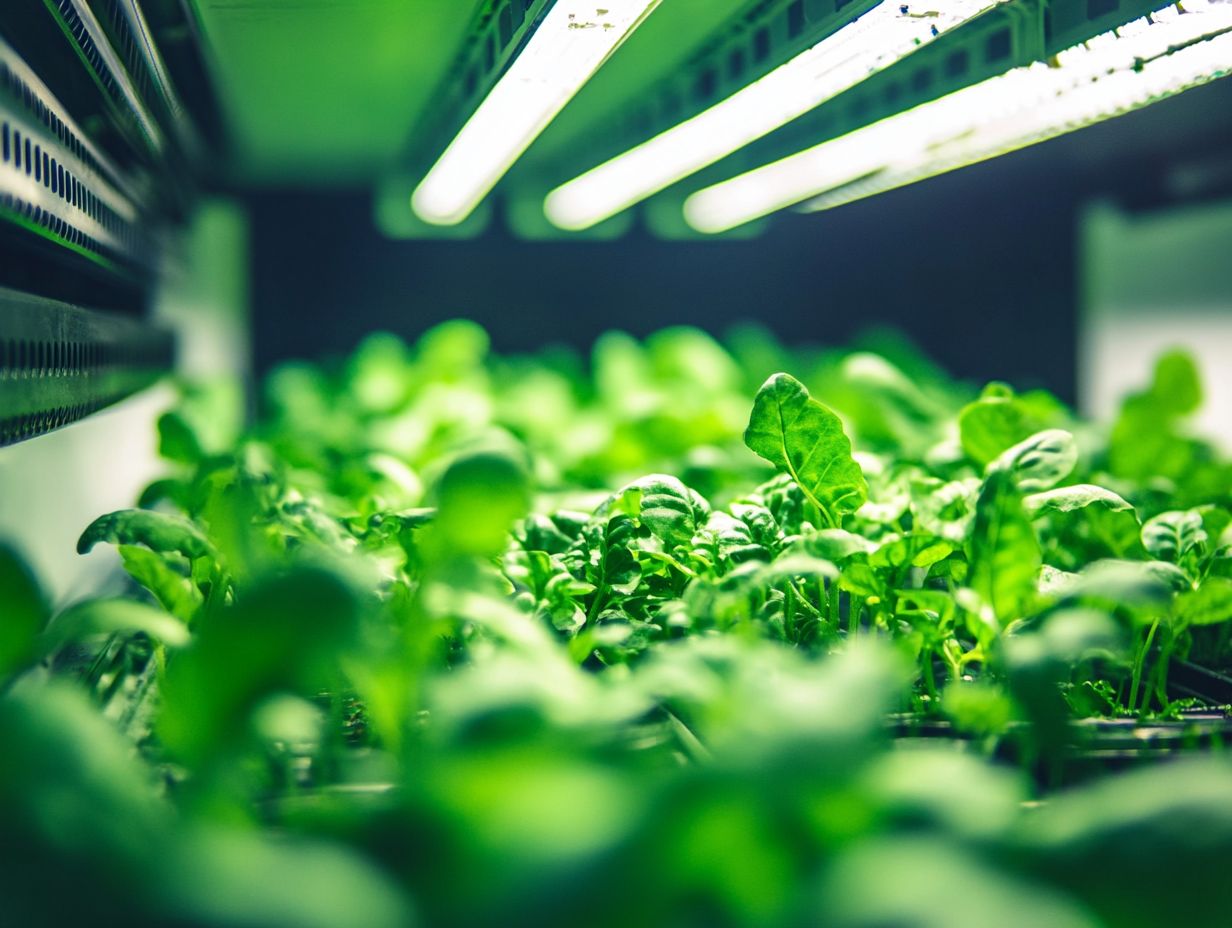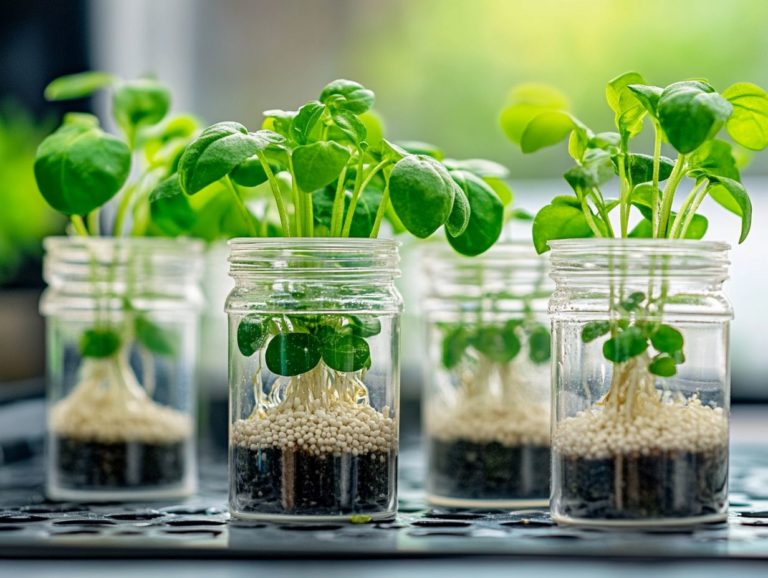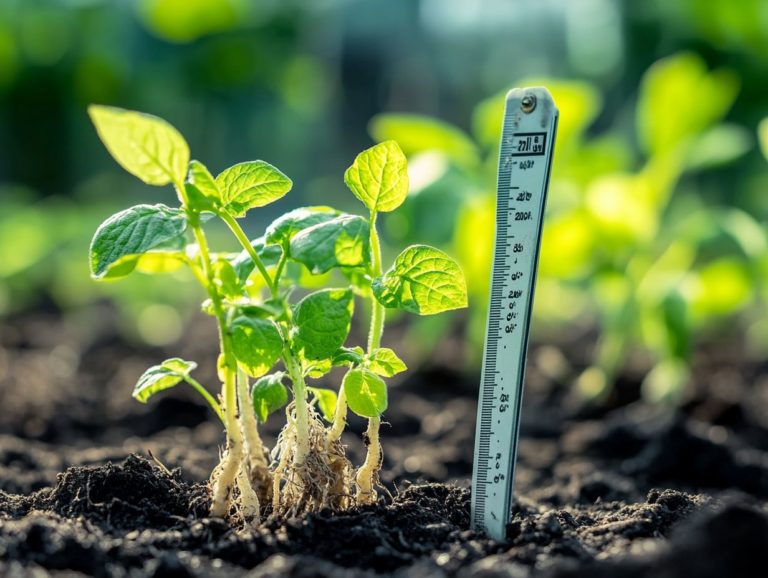5 Key Nutrient Tips for Hydroponic Success
Hydroponics presents an innovative approach to growing plants without soil. Achieving success depends on one pivotal element: nutrient management.
This guide provides five essential tips to ensure your hydroponic plants receive the optimal nutrients at every growth stage. From selecting the perfect nutrient solution to monitoring pH levels and avoiding common pitfalls, you ll navigate nutrient management with confidence.
Whether you’re a novice or a seasoned grower, these insights will empower you to cultivate thriving plants.
Contents
- Key Takeaways:
- 1. Choose the Right Nutrient Solution
- 2. Monitor pH Levels
- 3. Adjust Nutrient Levels According to Plant Growth Stage
- 4. Keep a Regular Feeding Schedule
- 5. Flush the System Regularly
- Essential Nutrients for Hydroponic Plants
- How Can One Determine the Correct Nutrient Levels for Their Plants?
- What Are the Common Mistakes in Nutrient Management in Hydroponics?
- How Can One Troubleshoot Nutrient Deficiencies in Hydroponic Plants?
- What Are the Different Types of Nutrient Delivery Systems in Hydroponics?
- What Are the Best Practices for Nutrient Management in Hydroponics?
- Frequently Asked Questions
Key Takeaways:

- Choose the right nutrient solution for essential plant growth.
- Monitor pH levels regularly for optimal nutrient absorption.
- Adjust nutrient levels according to each plant’s growth stage.
1. Choose the Right Nutrient Solution
Choosing the right nutrient solution is crucial. It directly influences your plants’ growth and root development.
Hydroponic systems depend on a balanced mix of major nutrients to nourish your plants. Selecting the perfect nutrient solution is key.
This involves understanding various major nutrients like Nitrogen, Phosphorus, and Potassium (the famous NPK trio), along with essential micronutrients like calcium, magnesium, and sulfur.
Each plant type has its unique nutrient needs. For example, leafy greens thrive with higher nitrogen levels, while fruiting plants benefit from increased phosphorus for blooming. Achieving the ideal NPK ratio ensures vital processes like photosynthesis and root establishment occur effectively.
Micronutrients like iron, manganese, copper, and zinc are also essential for plant health.
By monitoring nutrient levels and making necessary adjustments, you can cater to your plants’ needs. This proactive approach leads to healthier yields and enhanced productivity.
2. Monitor pH Levels
Monitoring pH levels is essential for hydroponic success. The pH significantly influences nutrient availability and plant growth.
When pH levels stray from the optimal range, plants struggle to absorb the nutrients they need. This can lead to deficiencies that stunt growth or cause issues like yellowing leaves.
The best pH range for hydroponic systems is between 5.5 and 6.5. This range helps your plants absorb nutrients effectively.
Use various pH measurement tools, such as digital meters or test strips, to ensure accuracy. Regularly test your nutrient solution and make adjustments with pH up or down solutions to create an environment where your plants can thrive.
3. Adjust Nutrient Levels According to Plant Growth Stage
Adjusting nutrient levels based on your plants’ growth stage is crucial for optimal development.
During the early seedling stage, use a balanced nutrient solution rich in nitrogen to establish strong root systems and healthy foliage.
As your plants enter the vegetative phase, increase nitrogen levels to encourage vigorous growth and leaf development.
When your plants reach the flowering stage, their nutrient needs change. They require higher concentrations of phosphorus and potassium for blooming and fruit development. Timely adjustments to your nutrient solutions enhance photosynthesis and reduce the risk of nutrient burn.
Monitoring is essential. Knowing when to modify your nutrient solution can mean the difference between a bountiful harvest and a disappointing yield.
4. Keep a Regular Feeding Schedule

Establishing a regular feeding schedule is essential for ensuring consistent plant nutrition in hydroponics. Stick to this schedule, and watch your plants thrive like never before!
This routine guarantees that your plants receive the nutrients they need. It also helps you monitor their growth and development effectively. Different plants and their growth stages require tailored feeding strategies. For instance, leafy greens may thrive on frequent, lighter feedings, while fruiting plants might benefit from fewer, more concentrated feedings during critical growth stages.
An effective feeding schedule could involve daily nutrient solutions for seedlings, gradually transitioning to bi-weekly or weekly feedings for mature plants. This approach ensures your plants get the right balance of nitrogen, phosphorus, and potassium at every phase, maximizing their potential and your gardening success.
5. Flush the System Regularly
Regularly flushing your hydroponic system is crucial for maintaining nutrient balance and preventing harmful salts and residues. Don’t wait too long! Flushing your system every few weeks is crucial for keeping your plants healthy.
This process involves introducing clean water to the system, allowing it to circulate and wash away any substances that could impede your plants’ growth.
By establishing this flushing routine, you can enhance the health and vitality of your plants, ensuring they receive optimal nutrient uptake for robust development. The specific frequency may vary based on the types of nutrients you re using and the growth stage of your plants.
Water-soluble nutrients play a vital role in this process. They contribute to the cleanliness of your system and help maintain a balanced pH level. This, in turn, fosters an environment that is truly conducive to healthy growth.
Essential Nutrients for Hydroponic Plants
Understanding the essential nutrients for hydroponic plants is key to optimizing growth and achieving impressive yields. In hydroponic systems, plants absorb nutrients directly from water-soluble solutions. This makes it imperative to include both major nutrients and micronutrients in their diet.
To ensure your hydroponic plants receive a balanced supply of these nutrients, you’ll need to regularly monitor and adjust the nutrient solution to maintain ideal pH and how well the water conducts electricity. Additionally, understanding how to troubleshoot common hydroponic issues can help you identify any problems early. Nitrogen is essential for lush leaf growth and vibrant green foliage. Phosphorus plays a vital role in root formation and flowering, contributing to a bountiful harvest. Potassium enhances overall plant vigor and boosts disease resistance.
Micronutrients, though needed in smaller amounts, are equally critical. For instance, calcium is crucial for cell wall structure and growth, magnesium is a key component of chlorophyll, and iron is vital for chlorophyll synthesis. Additionally, boron and molybdenum also play important roles.
By routinely testing nutrient levels and adhering to a balanced feeding schedule, you can cultivate healthy, thriving plants in your hydroponic garden.
How Can One Determine the Correct Nutrient Levels for Their Plants?
Determining the correct nutrient levels for your hydroponic plants requires careful observation and analysis of their needs and growth conditions.
This process involves utilizing methods like leaf analysis and water testing to gain insights into specific nutrient uptake and deficiencies. By examining the leaves, you can spot visual indicators of nutrient stress, such as discoloration or unusual growth patterns. Water tests provide essential data on the concentrations of crucial elements in your nutrient solution.
As your plants progress through various growth stages, it’s vital to adjust your nutrient solutions based on their responses. For instance, during the flowering phase, you may find that an increased level of phosphorus is necessary. By closely monitoring these factors, you can fine-tune your approach, ensuring robust growth and bountiful harvests.
What Are the Common Mistakes in Nutrient Management in Hydroponics?

In hydroponics, overlooking nutrient management can spell disaster for your plants, resulting in poor health, stunted growth, and disappointing yields.
These mistakes typically arise from improper ratios of essential nutrients. This can lead to deficiencies or toxicities that slow down growth. You might underestimate the critical role of maintaining optimal pH levels in your nutrient solutions. This directly influences nutrient availability.
Both over-feeding and under-feeding can throw everything out of balance, creating an environment that stresses your plants. To tackle these challenges head-on, it’s essential to calibrate your nutrient solutions meticulously, monitor pH levels consistently, and adjust your feeding schedules according to the specific needs of your plants at various growth stages. Additionally, following the best practices for hydroponic water management can greatly enhance your gardening success.
How Can One Troubleshoot Nutrient Deficiencies in Hydroponic Plants?
Troubleshooting nutrient deficiencies in your hydroponic plants demands a sharp eye for symptoms and a solid grasp of essential nutrients.
You might notice common signs, such as yellowing leaves, which could indicate a nitrogen shortage. Stunted growth, on the other hand, often points to insufficient phosphorus or potassium. Catching these issues early is vital for maintaining the health of your plants.
To tackle these deficiencies, start by examining the nutrient solution for any imbalances. Adjusting the pH level to the optimal range and ensuring that your water-soluble fertilizers (these are fertilizers that dissolve in water, making nutrients easily available to plants) offer a complete spectrum of essential nutrients can make a significant difference.
By regularly monitoring and making timely adjustments to your feeding schedule, you can provide your plants with a more balanced nutrient uptake, ultimately boosting their growth and vitality.
What Are the Different Types of Nutrient Delivery Systems in Hydroponics?
Different nutrient delivery systems in hydroponics cater to your specific growing mediums and plant needs, providing tailored solutions for optimal plant nutrition.
Take deep water culture, for example. It creates an environment where roots are fully submerged in nutrient-rich, oxygenated water, allowing water-loving plants to grow rapidly and thrive.
Then there’s the nutrient film technique, which uses a thin film of nutrient solution that continuously flows over the roots. This method promotes efficient absorption and reduces excessive water use, making it perfect for leafy greens.
Aeroponics, on the other hand, suspends plants in the air and nourishes them with a fine mist of nutrients. This technique fosters rapid growth while minimizing the risk of disease and pests, making it particularly advantageous for delicate seedlings or high-value herbs.
Each of these approaches offers unique benefits designed to match the diverse growth habits and nutrient requirements of various plants.
What Are the Best Practices for Nutrient Management in Hydroponics?
Implementing best practices for nutrient management in hydroponics can greatly elevate both plant health and productivity.
Make it a priority to conduct regular testing and address any deficiencies or excesses. Equally important is maintaining an optimal pH level, as it directly impacts nutrient availability for your plants.
Ensuring a balanced nutrient solution is crucial, as each plant has its own unique requirements that can evolve throughout its growth stages. By closely monitoring plant health through careful observations and routine checks, you can gain valuable insights into their nutrient needs. For those interested in maximizing results, consider using 7 tips for successful hydroponic gardening. This knowledge gives you the power to make informed adjustments that foster robust growth and maximize yield.
Frequently Asked Questions
Here are some common questions that can help you troubleshoot nutrient management.

What are the 5 key nutrient tips for hydroponic success?
Here are 5 essential tips for hydroponic success: 1) Use balanced plant food, 2) Monitor and adjust pH levels, 3) Provide enough oxygen, 4) Ensure plants absorb nutrients well, and 5) Flush the system regularly.
Why is a balanced nutrient solution important?
A balanced nutrient solution supplies all the essential food plants need to grow. Without it, plants may lack nutrients, leading to slow growth or disease.
How do I monitor and adjust pH levels?
The ideal pH range for most hydroponic plants is 5.5 to 6.5. Check your solution with a pH meter and adjust it using pH up or down products.
Why is oxygenation important?
Oxygenation promotes root growth and helps plants absorb nutrients effectively. Without adequate oxygen, plants can weaken and become more prone to disease.
How can I ensure proper nutrient uptake?
To ensure proper nutrient uptake, maintain a balanced nutrient solution and monitor pH levels. Regularly flushing the system helps prevent blockages and nutrient buildup.
How often should I flush my hydroponic system?
Flush your hydroponic system every 1-2 weeks. This keeps nutrients balanced and involves draining the old solution and replacing it with fresh, pH-balanced water.






